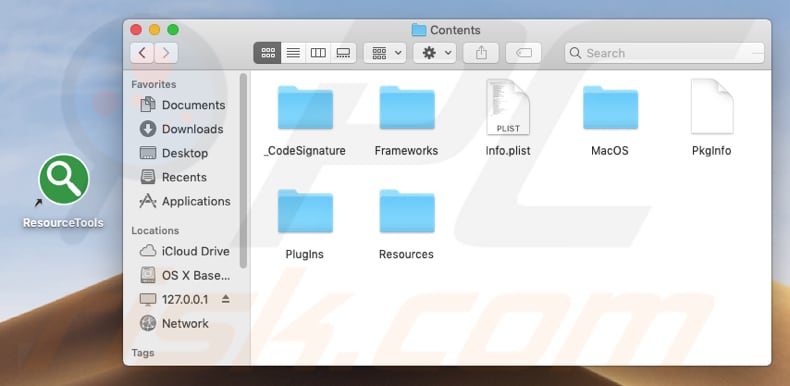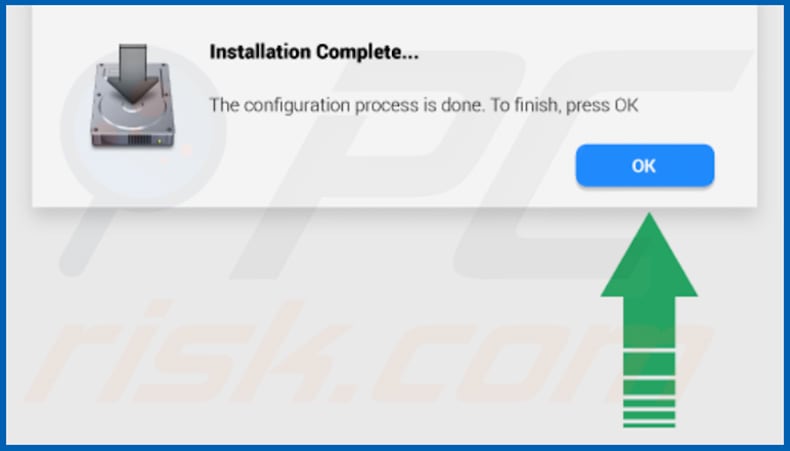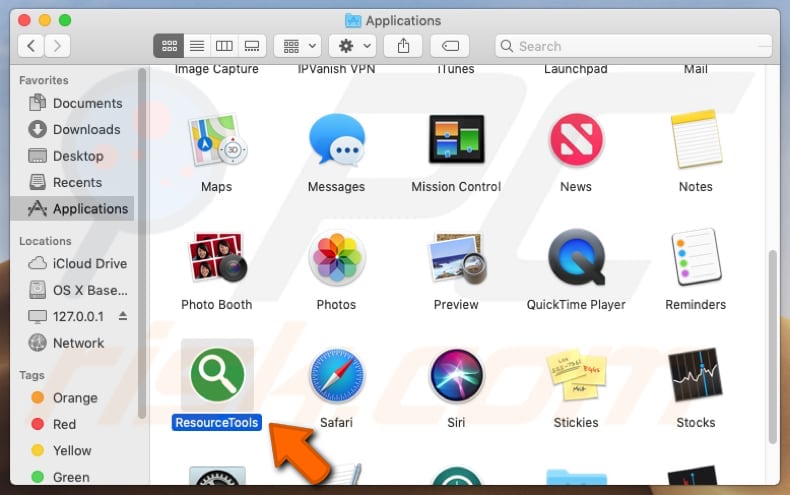Get free scan and check if your device is infected.
Remove it nowTo use full-featured product, you have to purchase a license for Combo Cleaner. Seven days free trial available. Combo Cleaner is owned and operated by RCS LT, the parent company of PCRisk.com.
What is Resourcetools?
Resourcetools is presented as an app that allows users to easily browse the web, however, its real purpose is to redirect them through a dubious URL before showing results generated by Google. Therefore, this app can force people to use other search engines (such as Bing and Yahoo).
Additionally, apps such as Resourcetools are categorized as a potentially unwanted applications (PUAs) - adware that feeds users with unwanted, intrusive advertisements. Typically, these PUAs also record data. We recommend that you uninstall Resourcetools and avoid PUAs in future.

When people with Resourcetools app installed on their systems search via Google, they are forced to visit a dubious URL address, which is opened before receiving any search results. These apps also promote other search engines. Rather than allowing users to search with their preferred search engines, they are forced to use search.yahoo.com or bing.com.
Furthermore, adware-type apps serve users with intrusive (and often deceptive) ads that, if clicked, open untrustworthy websites. Some of these sites might be used to promote malware (malicious software) or other unwanted apps. Furthermore, when clicked, the ads might execute scripts that cause unwanted downloads and installations.
These PUAs are also used to collect user-system information including IP addresses, URLs of visited websites, entered search queries, geolocations, and other details relating to users' browsing habits. Adware developers share this data with other parties (who might be cyber criminals) who misuse it to generate revenue.
To avoid unwanted downloads and installations, redirects to dubious web pages, and other problems relating to privacy and browsing safety, we advise that you uninstall Resourcetools immediately.
| Name | Resourcetools 1.0 adware |
| Threat Type | Mac malware, Mac virus |
| Symptoms | Your Mac becomes slower than normal, you see unwanted pop-up ads, you are redirected to dubious websites. |
| Detection Names (ResourceTools.app.zip) | Full list of detections (VirusTotal). |
| Distribution methods | Deceptive pop-up ads, free software installers (bundling), fake flash player installers, torrent file downloads. |
| Damage | Internet browser tracking (potential privacy issues), display of unwanted ads, redirects to dubious websites, loss of private information. |
| Malware Removal (Windows) |
To eliminate possible malware infections, scan your computer with legitimate antivirus software. Our security researchers recommend using Combo Cleaner. Download Combo CleanerTo use full-featured product, you have to purchase a license for Combo Cleaner. 7 days free trial available. Combo Cleaner is owned and operated by RCS LT, the parent company of PCRisk.com. |
There are many adware-type apps online. Some examples are StudyDisplay, MatchKnowledge, and Top Results. These apps have one main purpose: to display intrusive advertisements. Furthermore, they are often advertised as legitimate, useful tools, and thus people commonly download them intentionally.
How did Resourcetools install on my computer?
Typically, people download and install adware and other PUAs unintentionally. This happens, they are bundled into set-ups of other software - PUAs are installed with other, regular programs. Developers hide information about bundled apps in "Custom", "Advanced" and other similar parts of the download/installation set-ups.
PUAs can be dismissed, however, many people download and install software without even checking the aforementioned settings, thus granting permission for PUAs to be downloaded and installed. PUAs can also be downloaded and installed through intrusive ads - clicking ads allows them to run scripts that cause this problem.
How to avoid installation of potentially unwanted applications?
You are advised to download software from legitimate, official websites. Do not use sources such as Peer-to-Peer networks (i.e., torrent clients, eMule), dubious pages, third party downloaders and so on - they might distribute PUAs or even malware. Check each download/installation setup (settings such as "Custom", "Advanced") and dismiss additionally-included apps (PUAs).
Do not trust or click intrusive ads, especially if they are displayed on dubious websites. If the default browser causes unwanted redirects, or unwanted ads appear on all web pages, this is probably caused by an installed PUA. Check the list of installed browser apps (extensions, plug-ins, and add-ons) and remove suspicious, unwanted applications immediately.
Also remove any unwanted programs installed on the operating system. If your computer is already infected with Resourcetools, we recommend running a scan with Combo Cleaner Antivirus for Windows to automatically eliminate this adware.
Pop-up window displayed once Resourcetools installation is over:

Resourcetools adware in Applications folder:

Instant automatic malware removal:
Manual threat removal might be a lengthy and complicated process that requires advanced IT skills. Combo Cleaner is a professional automatic malware removal tool that is recommended to get rid of malware. Download it by clicking the button below:
DOWNLOAD Combo CleanerBy downloading any software listed on this website you agree to our Privacy Policy and Terms of Use. To use full-featured product, you have to purchase a license for Combo Cleaner. 7 days free trial available. Combo Cleaner is owned and operated by RCS LT, the parent company of PCRisk.com.
Quick menu:
- What is Resourcetools?
- STEP 1. Remove Resourcetools related files and folders from OSX.
- STEP 2. Remove Resourcetools ads from Safari.
- STEP 3. Remove Resourcetools adware from Google Chrome.
- STEP 4. Remove Resourcetools ads from Mozilla Firefox.
Video showing how to remove Resourcetools adware using Combo Cleaner:
Resourcetools adware removal:
Remove Resourcetools-related potentially unwanted applications from your "Applications" folder:

Click the Finder icon. In the Finder window, select "Applications". In the applications folder, look for "MPlayerX", "NicePlayer", or other suspicious applications and drag them to the Trash. After removing the potentially unwanted application(s) that cause online ads, scan your Mac for any remaining unwanted components.
DOWNLOAD remover for malware infections
Combo Cleaner checks if your computer is infected with malware. To use full-featured product, you have to purchase a license for Combo Cleaner. 7 days free trial available. Combo Cleaner is owned and operated by RCS LT, the parent company of PCRisk.com.
Remove adware-related files and folders

Click the Finder icon, from the menu bar. Choose Go, and click Go to Folder...
 Check for adware generated files in the /Library/LaunchAgents/ folder:
Check for adware generated files in the /Library/LaunchAgents/ folder:

In the Go to Folder... bar, type: /Library/LaunchAgents/

In the "LaunchAgents" folder, look for any recently-added suspicious files and move them to the Trash. Examples of files generated by adware - "installmac.AppRemoval.plist", "myppes.download.plist", "mykotlerino.ltvbit.plist", "kuklorest.update.plist", etc. Adware commonly installs several files with the exact same string.
 Check for adware generated files in the ~/Library/Application Support/ folder:
Check for adware generated files in the ~/Library/Application Support/ folder:

In the Go to Folder... bar, type: ~/Library/Application Support/

In the "Application Support" folder, look for any recently-added suspicious folders. For example, "MplayerX" or "NicePlayer", and move these folders to the Trash.
 Check for adware generated files in the ~/Library/LaunchAgents/ folder:
Check for adware generated files in the ~/Library/LaunchAgents/ folder:

In the Go to Folder... bar, type: ~/Library/LaunchAgents/

In the "LaunchAgents" folder, look for any recently-added suspicious files and move them to the Trash. Examples of files generated by adware - "installmac.AppRemoval.plist", "myppes.download.plist", "mykotlerino.ltvbit.plist", "kuklorest.update.plist", etc. Adware commonly installs several files with the exact same string.
 Check for adware generated files in the /Library/LaunchDaemons/ folder:
Check for adware generated files in the /Library/LaunchDaemons/ folder:

In the "Go to Folder..." bar, type: /Library/LaunchDaemons/

In the "LaunchDaemons" folder, look for recently-added suspicious files. For example "com.aoudad.net-preferences.plist", "com.myppes.net-preferences.plist", "com.kuklorest.net-preferences.plist", "com.avickUpd.plist", etc., and move them to the Trash.
 Scan your Mac with Combo Cleaner:
Scan your Mac with Combo Cleaner:
If you have followed all the steps correctly, your Mac should be clean of infections. To ensure your system is not infected, run a scan with Combo Cleaner Antivirus. Download it HERE. After downloading the file, double click combocleaner.dmg installer. In the opened window, drag and drop the Combo Cleaner icon on top of the Applications icon. Now open your launchpad and click on the Combo Cleaner icon. Wait until Combo Cleaner updates its virus definition database and click the "Start Combo Scan" button.

Combo Cleaner will scan your Mac for malware infections. If the antivirus scan displays "no threats found" - this means that you can continue with the removal guide; otherwise, it's recommended to remove any found infections before continuing.

After removing files and folders generated by the adware, continue to remove rogue extensions from your Internet browsers.
Remove malicious extensions from Internet browsers
 Remove malicious Safari extensions:
Remove malicious Safari extensions:

Open the Safari browser, from the menu bar, select "Safari" and click "Preferences...".

In the preferences window, select "Extensions" and look for any recently-installed suspicious extensions. When located, click the "Uninstall" button next to it/them. Note that you can safely uninstall all extensions from your Safari browser - none are crucial for regular browser operation.
- If you continue to have problems with browser redirects and unwanted advertisements - Reset Safari.
 Remove malicious extensions from Google Chrome:
Remove malicious extensions from Google Chrome:

Click the Chrome menu icon ![]() (at the top right corner of Google Chrome), select "More Tools" and click "Extensions". Locate all recently-installed suspicious extensions, select these entries and click "Remove".
(at the top right corner of Google Chrome), select "More Tools" and click "Extensions". Locate all recently-installed suspicious extensions, select these entries and click "Remove".

- If you continue to have problems with browser redirects and unwanted advertisements - Reset Google Chrome.
 Remove malicious extensions from Mozilla Firefox:
Remove malicious extensions from Mozilla Firefox:

Click the Firefox menu ![]() (at the top right corner of the main window) and select "Add-ons and themes". Click "Extensions", in the opened window locate all recently-installed suspicious extensions, click on the three dots and then click "Remove".
(at the top right corner of the main window) and select "Add-ons and themes". Click "Extensions", in the opened window locate all recently-installed suspicious extensions, click on the three dots and then click "Remove".

- If you continue to have problems with browser redirects and unwanted advertisements - Reset Mozilla Firefox.
Share:

Tomas Meskauskas
Expert security researcher, professional malware analyst
I am passionate about computer security and technology. I have an experience of over 10 years working in various companies related to computer technical issue solving and Internet security. I have been working as an author and editor for pcrisk.com since 2010. Follow me on Twitter and LinkedIn to stay informed about the latest online security threats.
PCrisk security portal is brought by a company RCS LT.
Joined forces of security researchers help educate computer users about the latest online security threats. More information about the company RCS LT.
Our malware removal guides are free. However, if you want to support us you can send us a donation.
DonatePCrisk security portal is brought by a company RCS LT.
Joined forces of security researchers help educate computer users about the latest online security threats. More information about the company RCS LT.
Our malware removal guides are free. However, if you want to support us you can send us a donation.
Donate
▼ Show Discussion